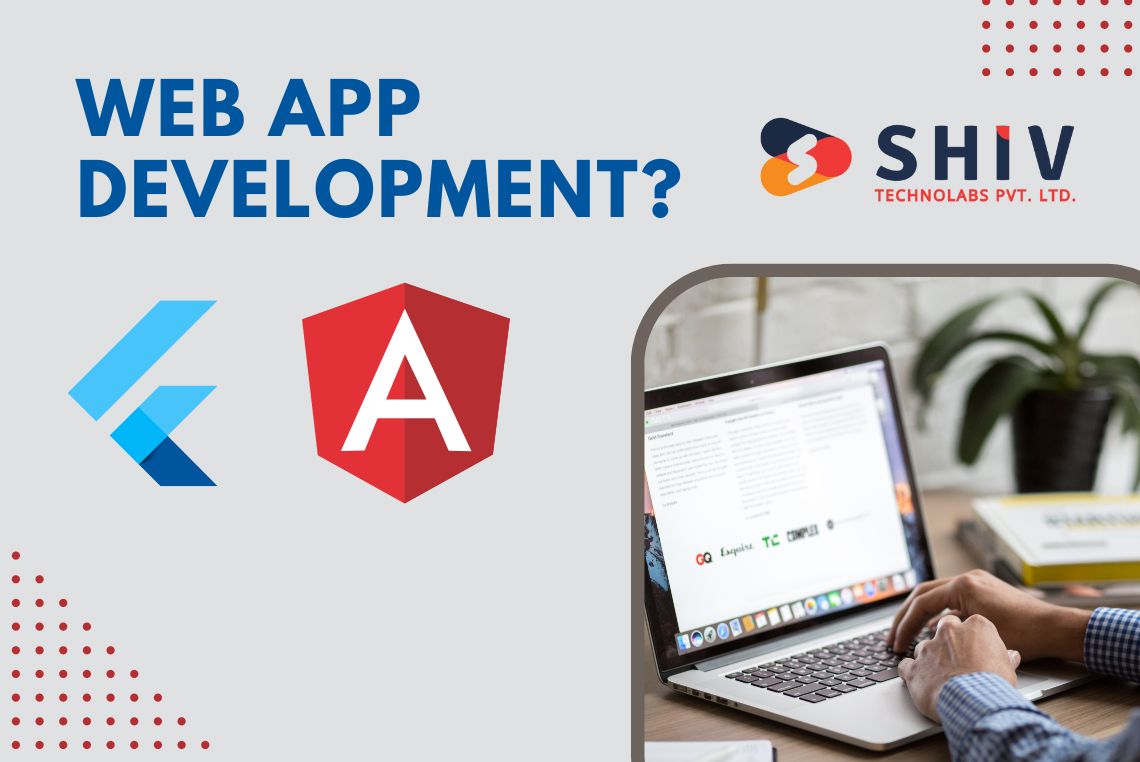Table of Contents
Web app development has evolved significantly, offering a variety of frameworks and tools to choose from. Two popular choices among developers are Flutter and Angular. Both have their strengths and weaknesses, making it crucial to understand their features, performance, and suitability for different projects. This article will compare Flutter and Angular to help you decide which is better for your web app development needs.
Introduction to Flutter and Angular

Flutter is an open-source UI software development kit created by Google. It is used to develop applications for Android, iOS, Linux, Mac, Windows, Google Fuchsia, and the web from a single codebase. Flutter is known for its expressive and flexible UI, fast performance, and a rich set of pre-designed widgets.
Angular, developed by Google, is a platform and framework for building single-page client applications using HTML and TypeScript. Angular provides a robust architecture, powerful data binding, and a comprehensive set of tools for building complex web applications.
# Flutter Key Features
- Single Codebase: One of Flutter’s biggest advantages is that it allows developers to use a single codebase for both mobile and web applications. This significantly reduces development time and effort.
- Hot Reload: This feature lets developers see changes in real-time without restarting the application. It speeds up the development process and makes it easier to experiment with different designs.
- Rich Widgets: Flutter comes with a vast library of customizable widgets that help create visually appealing and consistent UIs across platforms.
- Performance: Flutter applications are compiled directly into machine code, which enhances their performance on both mobile and web platforms.
# Angular Key Features
- Two-Way Data Binding: Angular’s two-way data binding feature simplifies the synchronization between the model and the view, reducing the amount of boilerplate code.
- Dependency Injection: Angular’s dependency injection system improves the modularity and testability of the code.
- Component-Based Architecture: Angular’s architecture is based on components, making it easier to manage and reuse code.
- CLI and Tooling: Angular provides a powerful CLI and a suite of tools for testing, building, and deploying applications, which streamlines the development process.
# Flutter vs Angular for Web App Development
| Feature/Aspect | Flutter | Angular |
|---|---|---|
| Framework Type | UI toolkit for building natively compiled applications across mobile, web, and desktop | Platform and framework for building single-page client applications using HTML and TypeScript |
| Language | Dart | TypeScript |
| Learning Curve | Moderate (especially if familiar with Dart) | Steep (requires understanding TypeScript and Angular’s architecture) |
| UI Components | Rich set of customizable widgets | Limited out-of-the-box, but extensive third-party libraries available |
| Performance | Near-native performance with Skia graphics engine | Efficient with JIT and AOT compilation, but may lag in mobile performance compared to Flutter |
| Hot Reload | Yes, for instant UI updates | Limited (refresh required for most changes) |
| Single Codebase | Yes, for mobile, web, and desktop | Primarily for web applications, with mobile support via Angular NativeScript |
| Community and Support | Growing community, strong support from Google | Large, mature community, extensive resources and third-party libraries |
| State Management | Built-in solutions (e.g., Provider, Riverpod) | Variety of third-party libraries (e.g., NgRx, Akita) |
| Tooling and CLI | Strong tooling with Flutter CLI | Powerful Angular CLI and extensive development tools |
| Scalability | Suitable for small to medium projects, scales with limitations for very large apps | Highly scalable, ideal for large, complex applications |
| Deployment | Easy deployment for multiple platforms | Streamlined deployment for web, with robust tools for continuous integration and delivery |
| Testing | Robust testing framework built-in | Comprehensive testing tools and libraries available |
| Integration | Good integration with popular backend services and APIs | Excellent integration with various backend services and APIs |
| Cost of Development | Generally lower due to single codebase | Can be higher, especially for separate web and mobile development |
Performance Comparison
Performance is a critical factor in choosing a framework for web app development. Both Flutter and Angular offer excellent performance, but they achieve it in different ways.
Flutter compiles to native code, which means it runs directly on the hardware, providing near-native performance. The use of the Skia graphics engine ensures smooth animations and transitions, making Flutter apps highly responsive.
Angular, on the other hand, uses a Just-In-Time (JIT) and Ahead-Of-Time (AOT) compilation to optimize performance. Angular’s change detection mechanism efficiently updates the DOM, ensuring smooth user interactions. However, being a web-centric framework, Angular might not match the performance of Flutter in mobile applications.
# Development Experience
The development experience can significantly impact productivity and the overall success of a project.
Flutter offers a highly productive development environment with features like hot reload, which allows developers to see changes instantly. The extensive widget library and robust documentation make it easy to get started and build complex UIs quickly.
Angular provides a mature development ecosystem with a powerful CLI, comprehensive documentation, and a strong community. The steep learning curve can be a challenge for beginners, but once mastered, Angular’s structured approach and rich features can enhance productivity.
Suitability for Different Projects

The choice between Flutter and Angular largely depends on the specific requirements of your project.
# When to Choose Flutter:
- If you need a single codebase for both mobile and web applications.
- If you prioritize a rich, consistent UI across platforms.
- If performance is a critical factor, especially for mobile apps.
# When to Choose Angular:
- If you are building a complex, large-scale web application.
- If you need strong support for data binding and dependency injection.
- If you prefer a framework with a mature ecosystem and extensive tooling.
Use Cases and Real-World Examples
Flutter has been used by companies like Alibaba, Google Ads, and Reflectly to build high-performance mobile and web applications. Its ability to deliver a consistent experience across platforms makes it a popular choice for startups and established companies alike.
Angular is widely used by enterprises for building robust and scalable web applications. Companies like Google, Microsoft, and IBM have leveraged Angular to create complex applications that handle large volumes of data and traffic.
# Can Flutter Build Web Apps?
Yes, Flutter can build web apps. Initially designed for mobile, Flutter has evolved to support web and desktop applications. With Flutter for Web, developers can create high-performance web applications using the same codebase they use for mobile apps. This capability simplifies the development process and reduces maintenance costs.
# Can Flutter Be Used for Desktop Apps?
Yes, Flutter can be used for desktop apps. Flutter’s support for desktop platforms (Windows, macOS, and Linux) allows developers to create native-like desktop applications using the same codebase as their mobile and web apps. This multi-platform support is one of Flutter’s key advantages.
# Can You Make Web Apps with Flutter?
Absolutely. Flutter’s web support is designed to deliver a high-quality experience on modern browsers. Developers can create responsive web applications with smooth animations and fast load times, leveraging Flutter’s rich set of widgets and tools.
# How Much Does Flutter App Development Cost?
The cost of Flutter app development depends on various factors, including the complexity of the app, the number of features, the development team’s location, and the project’s timeline. On average, Flutter app development can range from $15,000 to $100,000 or more. The single codebase approach can reduce costs compared to developing separate native apps for different platforms.
Conclusion
Both Flutter and Angular have their unique strengths and are suitable for different types of projects. Flutter excels in creating high-performance, cross-platform applications with a single codebase, making it ideal for startups and companies looking to save on development costs. Angular, with its robust architecture and extensive tooling, is well-suited for large-scale, complex web applications.
Choosing between Flutter and Angular ultimately depends on your project requirements, team expertise, and long-term goals. By understanding the features, performance, and development experience of each framework, you can make an informed decision that aligns with your needs.
In conclusion, both Flutter and Angular offer powerful tools and capabilities for building modern, efficient, and user-friendly web applications. If you are looking for a versatile solution that allows for cross-platform development, Flutter is an excellent choice, especially for those seeking to streamline their development process and reduce costs.
For businesses in Australia, leveraging Flutter app development services can provide a competitive edge with its single codebase approach. On the other hand, Angular is ideal for large-scale, complex web applications that require a robust architecture and extensive tooling. When deciding between the two, consider your specific project needs and long-term goals. For expert guidance and development, partnering with a Flutter app development company in Australia can ensure the success of your project, delivering high-quality applications tailored to your business requirements.



















